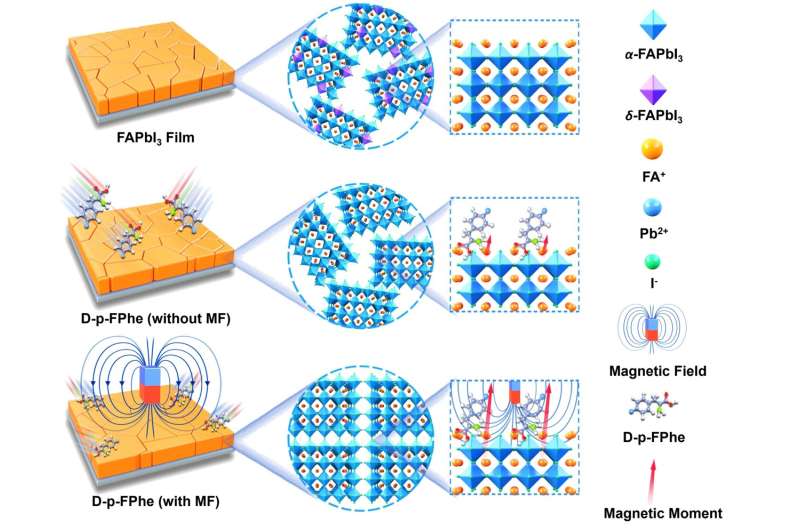This article has been reviewed according to Science X's editorial process and policies. Editors have highlighted the following attributes while ensuring the content's credibility:
fact-checked
trusted source
proofread
Magnetic-biased chiral molecules enable highly oriented perovskite films

In the realm of clean energy, metal halide perovskite solar cells (PSCs) have emerged as a focus, capturing significant attention for their extraordinary advancements. In just over a decade, their certified power conversion efficiency (PCE) has skyrocketed to 26.1%, approaching the upper limits seen in traditional crystalline silicon cells. What sets PSCs apart is their potential to surpass the 30% PCE threshold.
The key to optimizing solar devices lies in the deposition of high-quality perovskite films. Achieving minimal defect density and exceptional homogeneity becomes crucial for enhancing device performance. One commonly employed strategy involves introducing specific molecules during perovskite film crystallization to eliminate defects or prevent excessive components. However, conventional passivation strategies in perovskite (ABX3) photovoltaics pose limitations on the interaction between passivation molecules and sites A, B, and X.
At the core of perovskite crystallization regulation is the lead-iodine octahedral structure. Manipulating this process involves incorporating appropriate functional groups, facilitating the formation of uniform polycrystalline films with exceptional crystal orientation.
The unique molecular configuration of perovskites presents an opportunity to influence crystallization orientation by modulating the polarity between the perovskite material and introduced components. For example, the rotational motion of the A-site offers a means to strengthen the interaction between passivation molecules and perovskites, especially in the presence of an external field.
In this exciting context, a pioneering method was introduced to manipulate the crystal orientation of metal halide perovskites, by Prof. Wang's group from Soochow University. They introduced a set of chiral molecules and, using the inherent properties of the chiral molecules, established a quantified strong force between the chiral molecules and formamidine (FA) ions in perovskite, called the magnetic dipole moment.
The δ phase harmful to the device will inevitably be produced in the crystallization of conventional perovskite films, and the simple use of chiral passivation molecules can effectively regulate the composition of perovskite films, but the existence of magnetic dipole moments is not strong enough to play a role, and the orderly arrangement of the overall structure cannot be guaranteed.
However, the application of an external magnetic field can effectively enhance and regulate this effect, based on the spin-orbit coupling effect, so that the crystal orientation in the perovskite film can be precisely adjusted while optimizing the composition. Combined with theoretical computational support from Ilhan Yavuz, and a team of researchers at Marmara University, they further demonstrated the feasibility of this collaborative strategy.
In comparison to conventional passivation strategies involving the direct implementation of organic molecules, this method shows a significant increase in the interaction energy between chiral molecules and perovskites by several times. This substantial improvement ensures effective crystallization regulation and achieves a uniform perovskite film.
With the assistance of Xingyu Gao and a research team from the Shanghai Synchrotron Radiation Facility, researchers used in situ crystallization process detection technology to observe a significant improvement clearly and comprehensively in the quality of perovskite films under the synergistic effect. The work is published in the journal National Science Review.
This research fully proves the effectiveness of the collaborative strategy from both theoretical and experimental aspects, which significantly inhibits the possible defects in the device, and greatly improves the performance of the photovoltaic device.
Furthermore, the stability of devices is successfully preserved. This advancement not only boosts the efficiency of solar cells but also ensures their reliability over prolonged periods, marking a significant stride towards a more sustainable and efficient future in solar energy utilization.
More information: Jing Chen et al, Magnetic-biased chiral molecules enabling highly oriented photovoltaic perovskites, National Science Review (2023). DOI: 10.1093/nsr/nwad305


















